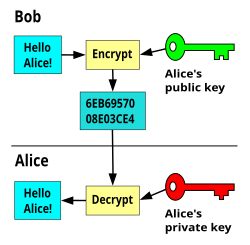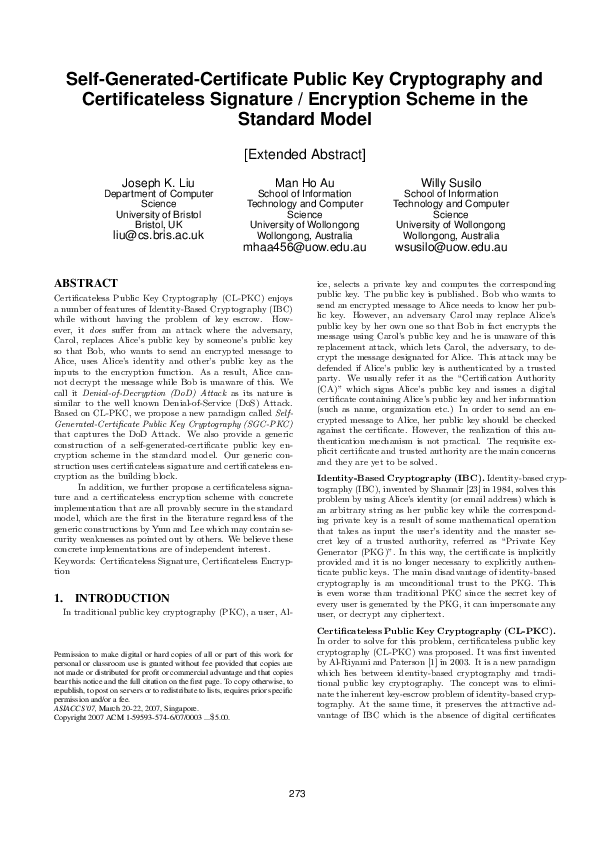- Self-generated-certificate Public Key Encryption Without Pairing Code
- Self-generated-certificate Public Key Encryption Without Pairing Software
- Self-generated-certificate Public Key Encryption Without Pairing Download
- Self-generated-certificate Public Key Encryption Without Pairing Key
- Self-generated-certificate Public Key Encryption Without Pairing Key
Private Key and public key are a part of encryption that encodes the information. Both keys work in two encryption systems called symmetric and asymmetric. Symmetric encryption (private-key encryption or secret-key encryption) utilize the same key for encryption and decryption. Asymmetric encryption utilizes a pair of keys like public and private key for better security where a message sender encrypts the message with the public key and the receiver decrypts it with his/her private key.
Public and Private key pair helps to encrypt information that ensures data is protected during transmission.
Public Key
AES is a symmetric cipher, thus only have one key both for encryption and decryption. Asymmetric ciphers like RSA have two keys. A public key for encryption and a private key for decryption. And for reddit, you can indeed answer without being logged in. To satisfy the requirement of practical applications, many certificateless encryption schemes (CLE) without pairing have been proposed. Recently, Lai et al. Proposed a CLE scheme without pairing and demonstrated that their scheme is provably secure in the random oracle model.
Public key uses asymmetric algorithms that convert messages into an unreadable format. A person who has a public key can encrypt the message intended for a specific receiver. The receiver with the private key can only decode the message, which is encrypted by the public key. The key is available via the public accessible directory.
Private Key
The private key is a secret key that is used to decrypt the message and the party knows it that exchange message. In the traditional method, a secret key is shared within communicators to enable encryption and decryption the message, but if the key is lost, the system becomes void. To avoid this weakness, PKI (public key infrastructure) came into force where a public key is used along with the private key. PKI enables internet users to exchange information in a secure way with the use of a public and private key.
Key Size and Algorithms
There are RSA, DSA, ECC (Elliptic Curve Cryptography) algorithms that are used to create a public and private key in public key cryptography (Asymmetric encryption). Due to security reason, the latest CA/Browser forum and IST advises to use 2048-bit RSA key. The key size (bit-length) of a public and private key pair decides how easily the key can be exploited with a brute force attack. The more computing power increases, it requires more strong keys to secure transmitting data.
-->This walkthrough demonstrates how to encrypt and decrypt content. The code examples are designed for a Windows Forms application. This application does not demonstrate real world scenarios, such as using smart cards. Instead, it demonstrates the fundamentals of encryption and decryption.
This walkthrough uses the following guidelines for encryption:
Use the RijndaelManaged class, a symmetric algorithm, to encrypt and decrypt data by using its automatically generated Key and IV.
Use the RSACryptoServiceProvider, an asymmetric algorithm, to encrypt and decrypt the key to the data encrypted by RijndaelManaged. Asymmetric algorithms are best used for smaller amounts of data, such as a key.
Note
If you want to protect data on your computer instead of exchanging encrypted content with other people, consider using the ProtectedData or ProtectedMemory classes.
The following table summarizes the cryptographic tasks in this topic.
| Task | Description |
|---|---|
| Creating a Windows Forms application | Lists the controls that are required to run the application. |
| Declaring global objects | Declares string path variables, the CspParameters, and the RSACryptoServiceProvider to have global context of the Form class. |
| Creating an asymmetric key | Creates an asymmetric public and private key value pair and assigns it a key container name. |
| Encrypting a file | Displays a dialog box to select a file for encryption and encrypts the file. |
| Decrypting a file | Displays a dialog box to select an encrypted file for decryption and decrypts the file. |
| Getting a private key | Gets the full key pair using the key container name. |
| Exporting a public key | Saves the key to an XML file with only public parameters. |
| Importing a public key | Loads the key from an XML file into the key container. |
| Testing the application | Lists procedures for testing this application. |
Self-generated-certificate Public Key Encryption Without Pairing Code
Prerequisites

You need the following components to complete this walkthrough:
- References to the System.IO and System.Security.Cryptography namespaces.

Creating a Windows Forms Application
Most of the code examples in this walkthrough are designed to be event handlers for button controls. The following table lists the controls required for the sample application and their required names to match the code examples.
| Control | Name | Text property (as needed) |
|---|---|---|
| Button | buttonEncryptFile | Encrypt File |
| Button | buttonDecryptFile | Decrypt File |
| Button | buttonCreateAsmKeys | Create Keys |
| Button | buttonExportPublicKey | Export Public Key |
| Button | buttonImportPublicKey | Import Public Key |
| Button | buttonGetPrivateKey | Get Private Key |
| Label | label1 | Key not set |
| OpenFileDialog | openFileDialog1 | |
| OpenFileDialog | openFileDialog2 |
Double-click the buttons in the Visual Studio designer to create their event handlers.
Declaring Global Objects
Self-generated-certificate Public Key Encryption Without Pairing Software
Add the following code to the Form's constructor. Edit the string variables for your environment and preferences.
Creating an Asymmetric Key
This task creates an asymmetric key that encrypts and decrypts the RijndaelManaged key. This key was used to encrypt the content and it displays the key container name on the label control.
Add the following code as the Click event handler for the Create Keys button (buttonCreateAsmKeys_Click).
Encrypting a File
This task involves two methods: the event handler method for the Encrypt File button (buttonEncryptFile_Click) and the EncryptFile method. The first method displays a dialog box for selecting a file and passes the file name to the second method, which performs the encryption.
The encrypted content, key, and IV are all saved to one FileStream, which is referred to as the encryption package.
The EncryptFile method does the following:
Creates a RijndaelManaged symmetric algorithm to encrypt the content.
Creates an RSACryptoServiceProvider object to encrypt the RijndaelManaged key.
Uses a CryptoStream object to read and encrypt the FileStream of the source file, in blocks of bytes, into a destination FileStream object for the encrypted file.
Determines the lengths of the encrypted key and IV, and creates byte arrays of their length values.
Writes the Key, IV, and their length values to the encrypted package.
The encryption package uses the following format:
Key length, bytes 0 - 3
IV length, bytes 4 - 7
Encrypted key
IV
Cipher text
You can use the lengths of the key and IV to determine the starting points and lengths of all parts of the encryption package, which can then be used to decrypt the file.
Add the following code as the Click event handler for the Encrypt File button (buttonEncryptFile_Click).
Add the following EncryptFile method to the form.

Decrypting a File
This task involves two methods, the event handler method for the Decrypt File button (buttonDecryptFile_Click), and the DecryptFile method. The first method displays a dialog box for selecting a file and passes its file name to the second method, which performs the decryption.
The Decrypt method does the following:
Creates a RijndaelManaged symmetric algorithm to decrypt the content.
Reads the first eight bytes of the FileStream of the encrypted package into byte arrays to obtain the lengths of the encrypted key and the IV.
Extracts the key and IV from the encryption package into byte arrays.
Creates an RSACryptoServiceProvider object to decrypt the RijndaelManaged key.
Uses a CryptoStream object to read and decrypt the cipher text section of the FileStream encryption package, in blocks of bytes, into the FileStream object for the decrypted file. When this is finished, the decryption is completed.
Add the following code as the Click event handler for the Decrypt File button.
Add the following DecryptFile method to the form.
Exporting a Public Key
This task saves the key created by the Create Keys button to a file. It exports only the public parameters.
This task simulates the scenario of Alice giving Bob her public key so that he can encrypt files for her. He and others who have that public key will not be able to decrypt them because they do not have the full key pair with private parameters.
Add the following code as the Click event handler for the Export Public Key button (buttonExportPublicKey_Click).
Importing a Public Key
This task loads the key with only public parameters, as created by the Export Public Key button, and sets it as the key container name.
Self-generated-certificate Public Key Encryption Without Pairing Download
This task simulates the scenario of Bob loading Alice's key with only public parameters so he can encrypt files for her.
Add the following code as the Click event handler for the Import Public Key button (buttonImportPublicKey_Click).
Getting a Private Key
This task sets the key container name to the name of the key created by using the Create Keys button. The key container will contain the full key pair with private parameters.
This task simulates the scenario of Alice using her private key to decrypt files encrypted by Bob.
Add the following code as the Click event handler for the Get Private Key button (buttonGetPrivateKey_Click).
Testing the Application
After you have built the application, perform the following testing scenarios.
To create keys, encrypt, and decrypt
Self-generated-certificate Public Key Encryption Without Pairing Key
Click the
Create Keysbutton. The label displays the key name and shows that it is a full key pair.Click the
Export Public Keybutton. Note that exporting the public key parameters does not change the current key.Click the
Encrypt Filebutton and select a file.Click the
Decrypt Filebutton and select the file just encrypted.Examine the file just decrypted.
Close the application and restart it to test retrieving persisted key containers in the next scenario.
To encrypt using the public key
Click the
Import Public Keybutton. The label displays the key name and shows that it is public only.Click the
Encrypt Filebutton and select a file.Click the
Decrypt Filebutton and select the file just encrypted. This will fail because you must have the private key to decrypt.
Self-generated-certificate Public Key Encryption Without Pairing Key
This scenario demonstrates having only the public key to encrypt a file for another person. Typically that person would give you only the public key and withhold the private key for decryption.
To decrypt using the private key
Click the
Get Private Keybutton. The label displays the key name and shows whether it is the full key pair.Click the
Decrypt Filebutton and select the file just encrypted. This will be successful because you have the full key pair to decrypt.